MSI Z97 Guard-Pro Review: Entry Level Z97 at $110
by Ian Cutress on August 20, 2014 6:00 AM EST- Posted in
- Motherboards
- Intel
- MSI
- Z97
CPU Benchmarks
Readers of our motherboard review section will have noted the trend in modern motherboards to implement a form of MultiCore Enhancement / Acceleration / Turbo (read our report here) on their motherboards. This does several things, including better benchmark results at stock settings (not entirely needed if overclocking is an end-user goal) at the expense of heat and temperature. It also gives in essence an automatic overclock which may be against what the user wants. Our testing methodology is ‘out-of-the-box’, with the latest public BIOS installed and XMP enabled, and thus subject to the whims of this feature. It is ultimately up to the motherboard manufacturer to take this risk – and manufacturers taking risks in the setup is something they do on every product (think C-state settings, USB priority, DPC Latency / monitoring priority, memory subtimings at JEDEC). Processor speed change is part of that risk, and ultimately if no overclocking is planned, some motherboards will affect how fast that shiny new processor goes and can be an important factor in the system build.
Point Calculations – 3D Movement Algorithm Test: link
3DPM is a self-penned benchmark, taking basic 3D movement algorithms used in Brownian Motion simulations and testing them for speed. High floating point performance, MHz and IPC wins in the single thread version, whereas the multithread version has to handle the threads and loves more cores.
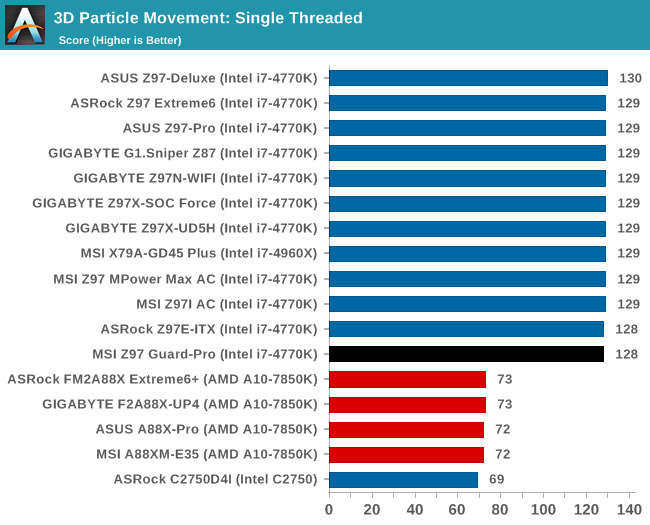
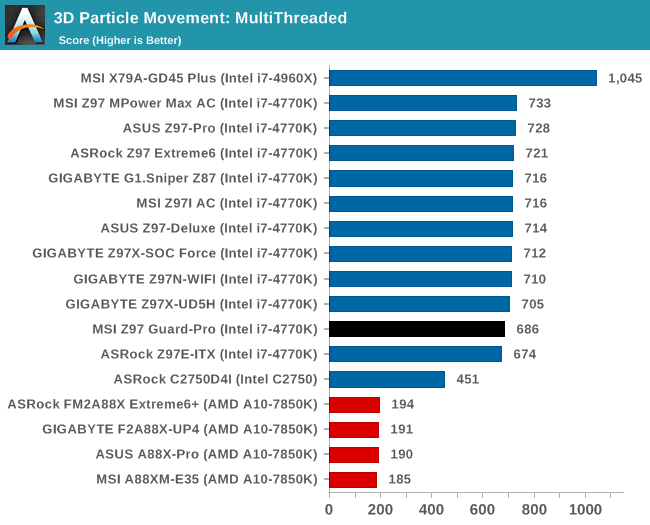
Compression – WinRAR 5.0.1: link
Our WinRAR test from 2013 is updated to the latest version of WinRAR at the start of 2014. We compress a set of 2867 files across 320 folders totaling 1.52 GB in size – 95% of these files are small typical website files, and the rest (90% of the size) are small 30 second 720p videos.
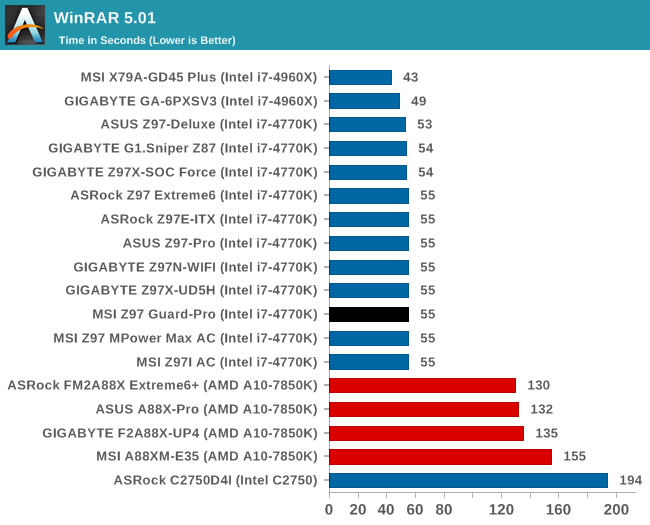
Image Manipulation – FastStone Image Viewer 4.9: link
Similarly to WinRAR, the FastStone test us updated for 2014 to the latest version. FastStone is the program I use to perform quick or bulk actions on images, such as resizing, adjusting for color and cropping. In our test we take a series of 170 images in various sizes and formats and convert them all into 640x480 .gif files, maintaining the aspect ratio. FastStone does not use multithreading for this test, and thus single threaded performance is often the winner.
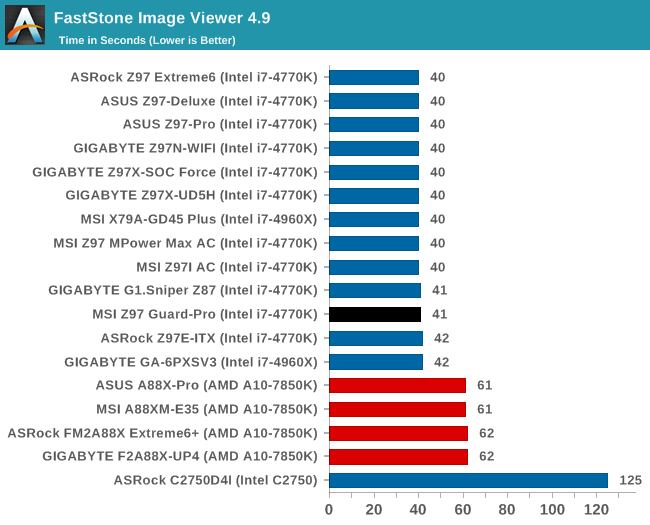
Video Conversion – Handbrake v0.9.9: link
Handbrake is a media conversion tool that was initially designed to help DVD ISOs and Video CDs into more common video formats. The principle today is still the same, primarily as an output for H.264 + AAC/MP3 audio within an MKV container. In our test we use the same videos as in the Xilisoft test, and results are given in frames per second.
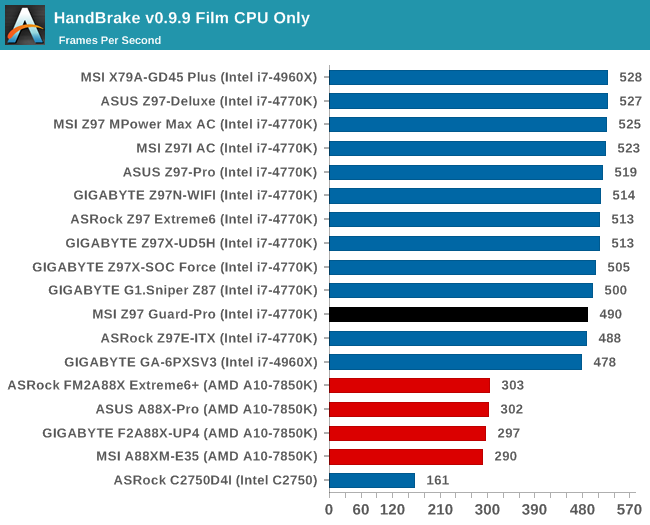
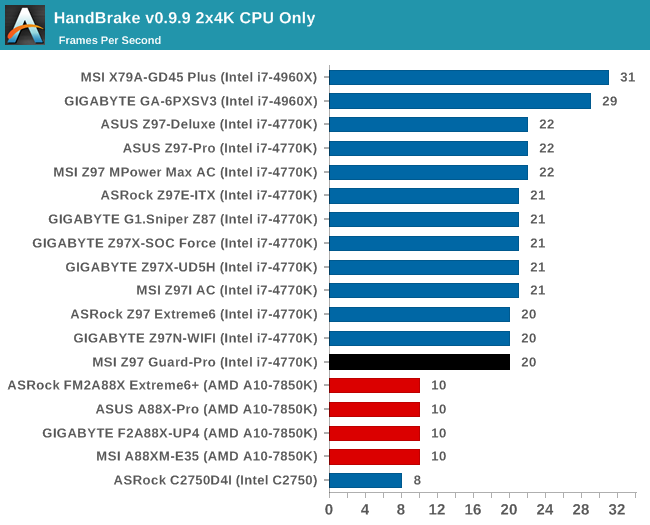
Rendering – PovRay 3.7: link
The Persistence of Vision RayTracer, or PovRay, is a freeware package for as the name suggests, ray tracing. It is a pure renderer, rather than modeling software, but the latest beta version contains a handy benchmark for stressing all processing threads on a platform. We have been using this test in motherboard reviews to test memory stability at various CPU speeds to good effect – if it passes the test, the IMC in the CPU is stable for a given CPU speed. As a CPU test, it runs for approximately 2-3 minutes on high end platforms.

Synthetic – 7-Zip 9.2: link
As an open source compression tool, 7-Zip is a popular tool for making sets of files easier to handle and transfer. The software offers up its own benchmark, to which we report the result.
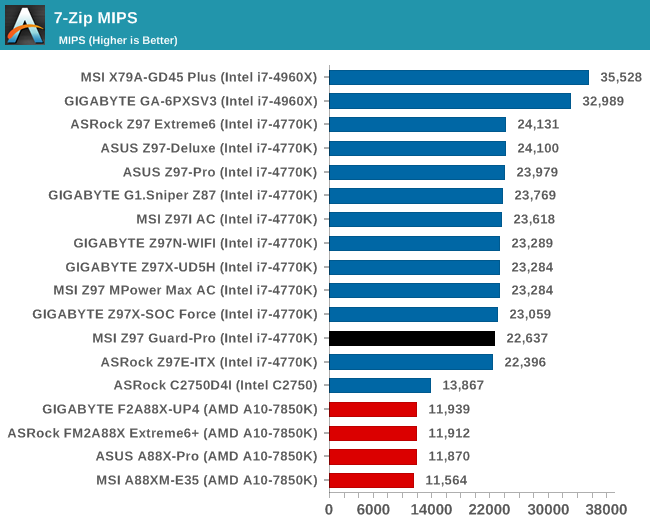










41 Comments
View All Comments
spugm1r3 - Wednesday, August 20, 2014 - link
http://www.legitreviews.com/intel-pentium-g3258-du...That shows a pretty robust selection of recent AAA titles faring as well on a Pentium as they do on an i7. Not all 2014 games are multithreaded. In fact, a vast majority aren't utilizing the resources offered by higher end processors. My point is, as long as Crysis or RTS games like Civ5 aren't your mainstays, invest the extra dollars where it counts.
Flunk - Wednesday, August 20, 2014 - link
Some of the benchmarks you linked to are as much as 40% slower on the overclocked Pentium, that's not what most people would call "on par". You're also discounting the fact that the 4770K overclocked would perform significantly better (Apples to apples here, if we've otherclocking we need to do it to both chips).The Pentium AE is a good low-end deal that will do for a lot of games, add in a mid-range GPU like a Radeon 270x or 280x and you've got a lot of performance for the buck. But it isn't comparable to even an overclocked i5 performance wise.
hojnikb - Wednesday, August 20, 2014 - link
If you want price/performance for games, then you either get athlon 750/760K, fx6300, i3 or i5.Everything else makes little sense and its a waste of money.
PentiumK and a z97 only makes sense if you're buying a stopgap system, that will soon get a better CPU. Buying pentiumK for longterm and expection to perform great is just crazy. FFS, its a lowend 2 core cpu.
DanNeely - Wednesday, August 20, 2014 - link
None of the benches they showed that actually matter are. No one uses a high end GPU to play at low quality settings and >200 FPS. That sort of BOGO benching to try and show CPU differences has been as stupid as it is common for a number of years. The ones at realistic GPU settings (1080p/max) were all within a few FPS of each other.If they wanted to try and show situations where the CPU mattered, min FPS or frame rate pacing data might work since both would capture any times where the CPU briefly did become a bottleneck. Alternately benches for games like CIV5 that do have major multi-threaded CPUbound functions would give the 4790 the ability to crush the pentium.
Medium term, I'm less confident that most games will only need 1 or 2 CPU threads will remain a valid assumption. The current generation of consoles have 8 slow CPUs vs prior generations having a few fast ones (and the PS3's secondary cores limitations making them harder to use). That's going to put more multi-threading pressure on the game engine developers; and makes commonly used engines being able to effectively use more than a handful of threads more likely in the future.
zero2dash - Wednesday, August 20, 2014 - link
^^^ This.G3258 is a good basic CPU, but there are plenty of reviews that show that it is nowhere near "on par" with an i5 (let alone an i7) in games. In some reviews, even an i3 does better than the G3258.
Intel needs to release an i3-K chip; that's all that the G3258 has demonstrated. It's a decent chip, especially when bundled with the MSI board for $100 at Microcenter, but, it's not "on par" with anything higher in Intel's product line on games (or anything, really).
austinsguitar - Wednesday, August 20, 2014 - link
umm... cheepo xeon ftw....Samus - Wednesday, August 20, 2014 - link
With AMD making quad core CPU's for $50, multithreaded software is becoming increasingly commonplace. Clock speed means little to modern software; specialized instructions and multithreaded performance mean everything, not to just AAA games. If you're playing 5 year old games, sure, but then why are you building a new PC for them in the first place?I've upgraded Pentium and Celeron PC's to i3's in offices and people even mention how much faster their Outlook and web browsing is, with the only real difference being hyper threading and cache.
xenol - Wednesday, August 20, 2014 - link
Games have always used more than two threads. I fired up Rainbow Six 3 the other day and found it had 12 threads going.Samus - Wednesday, August 20, 2014 - link
A Pentium K at 4.7GHz is comparable to an i3 at 3.4GHz (stock) in multithreaded tasks, which in 2014, is everything. The i3 costs $30 more and doesn't need to be overclocked. Or you could just get an i5 with an H-series motherboard and have more performance than the Pentium K could every achieve for a few dollars more.just4U - Thursday, August 21, 2014 - link
I use a 4790K for my main system. I also use a A10-5800 and a Non OC Pentium G3258. All systems have comparable specs (ram/ssd) When it comes to browsing the web, opening emails and using office programs I typically use.. I haven't noticed a difference.I actually don't really notice a difference until I head down to Dual Cores in the C2D 6x lineup below 3GHZ. I think their finally showing their age.